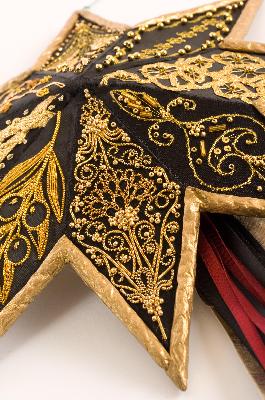Adoration of the Magi
artist: Maggi Ryan (Australian); artist: Dorothy Morgan (b.1947); artist: Alison Cole (Australian); artist: Lesley Uren; artist: Ann Brignall (active circa 2003); artist: Sue White (active circa 2003);
2003
See full details
Object Detail
Description
tableaux of adoration of the Magi figures are wearing costumes inspired by the Collection. The colours come from the house – raspberry from the entrance hall and staircase, green from the chandelier, gold from the yellow drawing room and brown from the furniture. The colour of the backdrop is of course the night sky but also a reference to the blue dining room and the star echoes those already seen on the front door and up the staircase, except that each point has a star inside it.
.1 Baby Jesus. The figures will sit on the floor amongst cut raffia to represent wheat (reference the decoration on the fire place in the Green Drawing Room)
.2 Mary. Dressed in blue (reference Pietra da Cortona painting) with small pearly beads holding her veil in place (reference beading on many pieces of porcelain in the Collection).
.3 Joseph. Dressed in rich brown with no embroidery (reference patina of mahogany furniture – because he was a carpenter.
.4 Red Magus.
.5 Yellow Magus decorated in metal thread work by Guild member Lesley Uren. One of the designs on the over garment is taken from the neoclassical urn of pink ground and painted with a view in Cumberland, Derby, circa 1810, combined with the green decorative elements on the soft furnishings of the brass inlaid sofa
The embroidery on the sleeves and side of the dress underneath took about 40 hours. Lesley first drew the design on paper and then transferred it on with a specially imported type of dressmaker’s non smudging carbon which dissolves after a couple of weeks. An alternative method is to trace the pattern on to tissue paper, and then place it on the wrong side of the garment and then work very small tacking stitches over the entire design which leaves the design on the right side. metal thread work is very time consuming particularly when you are doing the starts and finishes because the thread is not so pliable
.6 Green Magus decorated by Allison Cole. The fleur-de-lys on the coat is inspired by the design on the Green Chandelier in the Yellow Room. The coat took a while because Lesley used a technique where you embroider all the gold work as a slip on to a separate fabric and then you cut that out and apply it to the velvet.
Alison has been researching techniques – and the method she used on the coat is a very old method – it was the way that the ecclesiastical vestments were worked in Opus Anglicanum (circa 1600’s). It died out with the great plague because so many embroiderers died with the plague (at that time gold thread was only worked by men) After the plague the task then fell to lay people to embroider vestments but the lay people were not as good so English embroidery plueted-up to this time English embroidery had been at its height. Allison now knows why people don’t use it today – because it so difficult and time consuming.
The jacket took some three weeks solid work. The pattern around the edge of the Sir James Duke and Nephew plate is around the neck of the caftan. The embroidery on the caftan took two full days of needlework – working all night and day (25 hours) and then it took two days to sew the caftan on it. Here Allison used traditional gold work techniques which she describes in her own words as follows: I draw the design on to a glad bake and slide the dress makers carbon underneath and then you draw all over the top of your design and the carbon comes through to your fabric.
displayed for Christmas (before 2003), redressed in new embroidered costumes by The Embroiderers Guild of Victoria members for the Christmas 2003 exhibition
.1 Baby Jesus. The figures will sit on the floor amongst cut raffia to represent wheat (reference the decoration on the fire place in the Green Drawing Room)
.2 Mary. Dressed in blue (reference Pietra da Cortona painting) with small pearly beads holding her veil in place (reference beading on many pieces of porcelain in the Collection).
.3 Joseph. Dressed in rich brown with no embroidery (reference patina of mahogany furniture – because he was a carpenter.
.4 Red Magus.
.5 Yellow Magus decorated in metal thread work by Guild member Lesley Uren. One of the designs on the over garment is taken from the neoclassical urn of pink ground and painted with a view in Cumberland, Derby, circa 1810, combined with the green decorative elements on the soft furnishings of the brass inlaid sofa
The embroidery on the sleeves and side of the dress underneath took about 40 hours. Lesley first drew the design on paper and then transferred it on with a specially imported type of dressmaker’s non smudging carbon which dissolves after a couple of weeks. An alternative method is to trace the pattern on to tissue paper, and then place it on the wrong side of the garment and then work very small tacking stitches over the entire design which leaves the design on the right side. metal thread work is very time consuming particularly when you are doing the starts and finishes because the thread is not so pliable
.6 Green Magus decorated by Allison Cole. The fleur-de-lys on the coat is inspired by the design on the Green Chandelier in the Yellow Room. The coat took a while because Lesley used a technique where you embroider all the gold work as a slip on to a separate fabric and then you cut that out and apply it to the velvet.
Alison has been researching techniques – and the method she used on the coat is a very old method – it was the way that the ecclesiastical vestments were worked in Opus Anglicanum (circa 1600’s). It died out with the great plague because so many embroiderers died with the plague (at that time gold thread was only worked by men) After the plague the task then fell to lay people to embroider vestments but the lay people were not as good so English embroidery plueted-up to this time English embroidery had been at its height. Allison now knows why people don’t use it today – because it so difficult and time consuming.
The jacket took some three weeks solid work. The pattern around the edge of the Sir James Duke and Nephew plate is around the neck of the caftan. The embroidery on the caftan took two full days of needlework – working all night and day (25 hours) and then it took two days to sew the caftan on it. Here Allison used traditional gold work techniques which she describes in her own words as follows: I draw the design on to a glad bake and slide the dress makers carbon underneath and then you draw all over the top of your design and the carbon comes through to your fabric.
displayed for Christmas (before 2003), redressed in new embroidered costumes by The Embroiderers Guild of Victoria members for the Christmas 2003 exhibition
Maker and role
artist: Maggi Ryan (Australian)
artist: Dorothy Morgan (b.1947)
artist: Alison Cole (Australian)
artist: Lesley Uren
artist: Ann Brignall (active circa 2003)
artist: Sue White (active circa 2003)
artist: Dorothy Morgan (b.1947)
artist: Alison Cole (Australian)
artist: Lesley Uren
artist: Ann Brignall (active circa 2003)
artist: Sue White (active circa 2003)
Production place
Melbourne, Victoria, Australia
Production date
2003
Media description
mixed media
Project credit line
This digital record has been made available on TJC Collection Online through a significant donation from the OPENING DOORS fund, the generous support of The Friends of The Johnston Collection, and Digitisation Champion Christine Bell.
Accession number
6073
TJC reference number
2445


